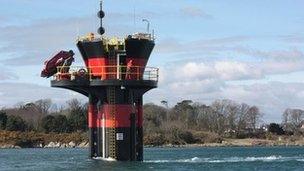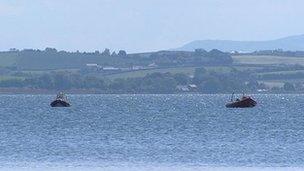Strangford Lough generator given all-clear
- Published

The world's first tidal current energy turbine, in Northern Ireland's Strangford Lough, has been given an environmental all-clear by a group of scientists.
Generating electricity from two massive underwater "propellers", the SeaGen, external was lowered into place in 2008.
It was bolted to the seabed in one of the world's fastest tidal currents.
However, questions were asked from the start over the environmental impact such a device could have.
Strangford Lough is one of Europe's most protected areas. It is a sea lough which provides unique habitats for marine and bird life.
A special area of conservation, it is also a Ramsar (wetlands of international importance) site and ASSI (Area of Special Scientific Interest).
The location was chosen for the turbine project because it offered sheltered waters close to shore but still exposed the generating device to the full rigours of the tides.
The tidal power is so substantial that in the early stages it actually damaged some of the blades.
Tidal power is an important part of any renewable energy plan as it is a guaranteed source of power and, unlike wind power, can be relied on every day.
SeaGen generates 1.2 megawatts, enough power for around 1500 homes.
Seal fears
Its operation had been limited by its licence conditions to daylight hours but these have now been lifted.
There had been fears that large marine mammals like seals would be hit by the propellers.
The environmental monitoring report giving the all-clear said: "There have been no changes in abundance of either seals or porpoises detected which can be attributed to SeaGen; seals and porpoises are continuing to swim past SeaGen, demonstrating a lack of any concern or hindrance."
No effect on tidal flows was found and the report said the seabed around the device has recovered following any disturbance during SeaGen's installation.
"This is the most comprehensive study of the environmental impact of marine energy devices undertaken anywhere in the world," marine biologist and diver David Erwin who chaired the monitoring group said.

Strangford Lough is one of Europe's most protected areas
"Given my long association with the lough, I was always confident that SeaGen could operate without any significant impact and I'm delighted that the results of five years painstaking work by some of the world's most-respected experts in their fields have shown this to be the case."
"The findings of the environmental monitoring programme give us confidence that SeaGen will be able to continue to operate with no likely significant impacts on the marine environment of Strangford Lough," said Frank Fortune, technical director of the environmental consultancy, Royal Haskoning, which prepared the report for SeaGen's owners MTC.
"This validates the innovative, adaptive management approach to monitoring and mitigation taken by MCT and supported by the Northern Ireland Environment Agency."
Getting this environmental all-clear is critical to the future of projects like SeaGen.
Tidal turbines offer the potential of hundreds of megawatts around the north coasts of Ireland, Scotland and Wales.